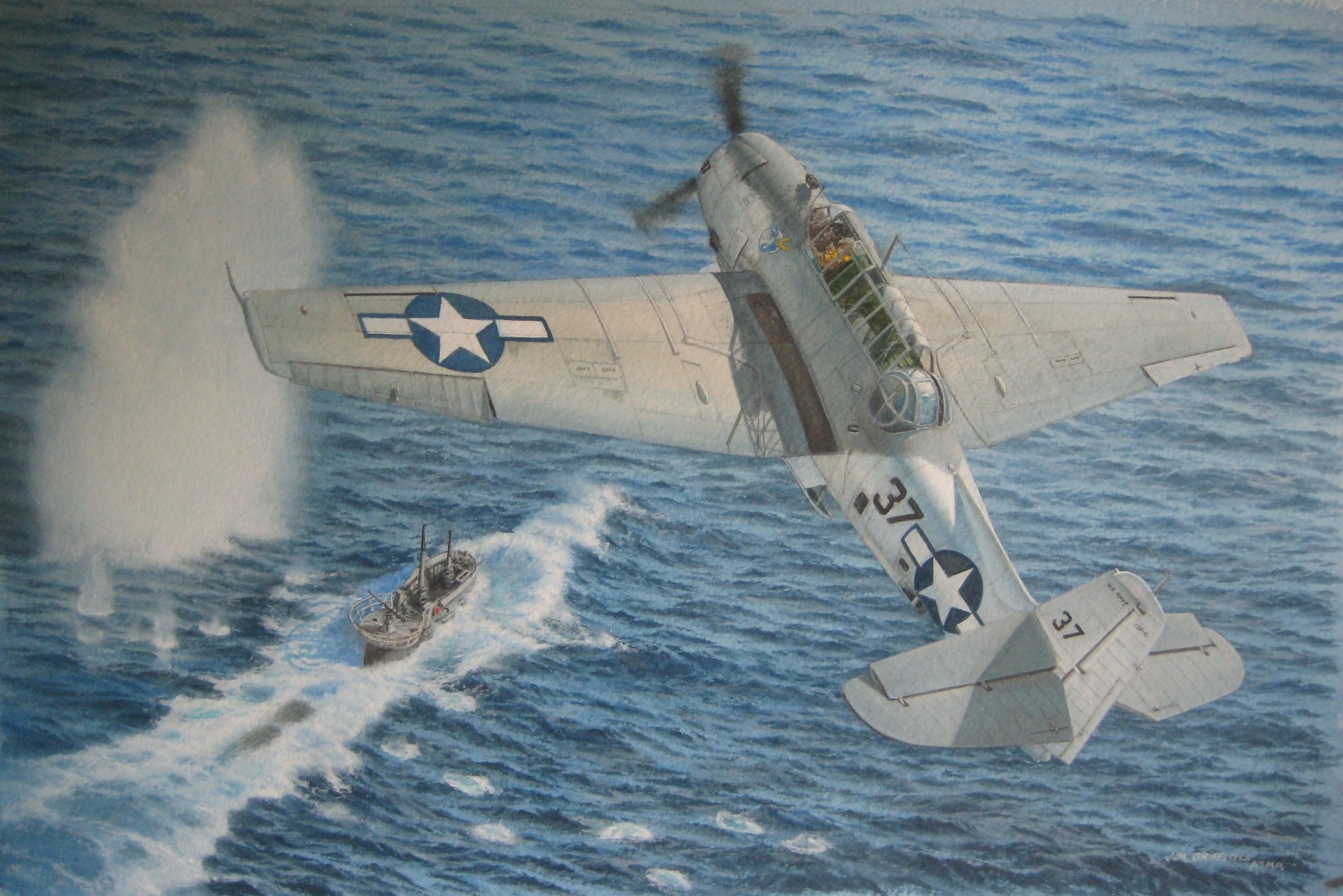When the Hunter Becomes the Hunted…
gouache, 12 1/2" x 19"
$5,800
This painting is my depiction of what my father’s air squadron, VC-55, did during their deployments aboard various ‘Bogue’ class carriers during WW II. Their mission was to search out and to attack and destroy German U-boats during the War in the Atlantic. In the painting a TBF-1C Avenger has come out of the sun and surprised a surfaced Type VII U-boat. The plane has strafed and dropped a 500 lb GP bomb at the submerging submarine, and the pilot is pulling up and banking around to attempt another run at the diving U-boat. The sharp-eyed viewer will notice that there is no machine gun in the ball turret. One of the things done to extend the range of the planes was to remove as much weight as possible from the aircraft and this included the gun, equipment, and the gunner in this turret. Another detail to see is the small 8 or 16 mm camera added to the top of the nose to record any attacks by the planes. The plane is in the USN Atlantic II scheme of dark gull grey and white; this was found to be the most effective camouflage for operations in this ocean. The time period for this painting would be late December, 1943, with VC-55 flying off of the USS Card(CVE-11). When the U.S. entered into WW II the German submarine threat was a well-established operation. During the first year of the war the U-boats operated almost with impunity off the U.S. Eastern and Gulf seaboards sinking many ships. The response was to use aircraft and blimps to accompany the convoys heading to and from Britain. These aircraft became the far-reaching eyes of the convoy and could notify the escorting military ships of a potential threat. This worked in reducing attacks off the coasts but unfortunately, these aircraft had a limited range, which left a huge center section of the Atlantic unprotected. The U-boats withdrew to this area and again enjoyed success.
To counter this threat the brilliant idea to convert C-3 freighter hulls to small aircraft carriers was utilized. These small escort carriers would carry up to twelve TBF/TBM Avenger and nine F4F Wildcat fighters. The carrier would be accompanied by either three or four(usually four) destroyer escorts and/or destroyers. This comprised a ‘Hunter-Killer’ group and these groups would be assigned to various stations in the Atlantic to continuously patrol and search out the U-boats. This tactic was quite successful. By war’s end, the threat of the U-boat had been drastically reduced. Another fascinating story was how the Avenger’s patrol range was extended. At war’s start, the Avengers were flying with their usual 3-man crew. It quickly became clear that the planes needed to stay in the air longer and thus began a series of ongoing removals of non-essential equipment and crew. One thing that was apparent was that the U-boats liked to run on the surface at night. They could air out the sub and actually make better speed on the surface. So, the Hunter-Killer groups began flying night missions. These became known as ‘Night Owl’ missions. By mid-1944 the Avenger had become the ultimate Night Owl. The plane no longer carried any bombs or depth bombs. Instead, a huge 200+ gallon fuel tank was in the bomb bay. In addition, two Wildcat underwing fuel tanks were added to the Avenger, one under each inboard section of the wing. All armament was removed. The pilot was given a .45 cal side arm and a thermos(or two) of coffee and launched at dusk to patrol all night returning to the carrier at dawn. The plane’s job was now to only search out the U-boat, locate it, and report back to the group and the group would then rush in to the area to try and locate and hopefully destroy the sub.
